The Wieliczka salt mine is located in the town of Wieliczka in southern Poland. The salt mines are 14km away from the city of Krakow. Since 1996 the salt mine is no longer used for commercial purposes. Due to lower salt prices and flooding of the mines. Explore the Wieliczka salt mine by going on a Tourist tour or the more adventurous Miner’s tour. Find out more about the history of the mines, the legend of Saint Kinga and the hidden Crystal caves.
Table of Contents
History
Early beginning
Salt was already obtained in the Neolithic times by boiling salt water in small clay pots. The oldest salt working tools were discovered in a small village close to Wieliczka and date back from this time period. In the 11th and 12th centuries salt springs weakened and disappeared. People started to construct wells to extract salt water. The region of Wieliczka developed because of the manual labour to manufacture salt. They built churches and settlements and trade started to flourish around this time.

The first visitor at the salt mine that they know by name was Nicolaus Copernicus. He probably visited in 1493. The famous astronomer has a monumental salt figure in a chamber that is named after him. You can see the artwork when visiting the Tourist route. See the left picture below.
It is said that the first salt rock was found by accident. After this discovery it was much easier to obtain salt and mining methods developed. In the late 13th century they built the first underground mining shaft. Around this time salt was expensive. The Polish King Casimir III issued the Saltwork Statute in 1368 which ensured that the mine developed for centuries to come.

Middle Ages
In 16th to the 18th century the salt mine expanded fast and the first maps were created. In the middle of the 17th century the salt mine reached the third level. They started to use gunpowder in the mines, a railway was built underground to transport salt in train carts and a power plant was commissioned.
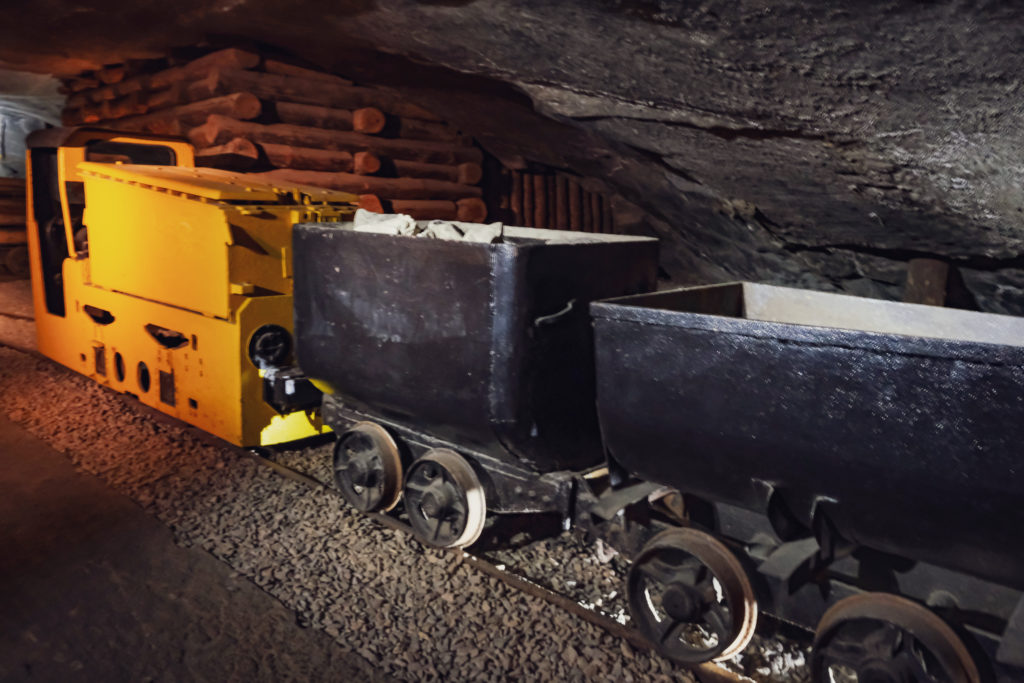
Tourism became an important source of income and investments were made to increase tourism. From 1868 a part of the route was accessible by a horse drawn railway. Boat rides on the salt lakes were organised and it was possible to descent like a miner using a rope into the mineshaft. During tours, the path was lightened with torches and an orchestra was playing. The tours in those days were more adventurous than the tours they organise now…!
After 1945
At this time the salt mine was nine levels deep. It reached it’s peak in the 1970s with a maximum depth of 327 metres. Since 1978 the salt mine is listed as UNESCO World Cultural and Natural Heritage. In 1994 it was declared as National Historic Monument by the President of the Republic of Poland.
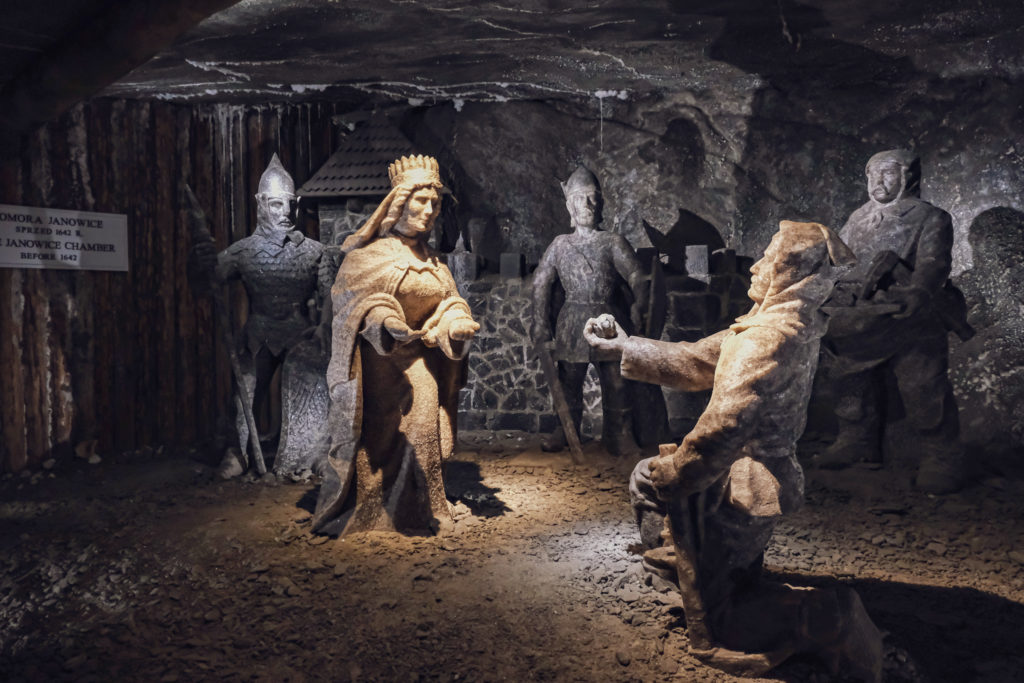
Today
Believe it or not but when you visit the salt mine you may see miners walking around. Several hundred miners still work in the mine to keep it safe. They also ensure the mine survives in the best possible conditions. The mine is no longer an industrial plant but an unusual place for events. There is also a Salt Mine Health Resort. The salty air has a soothing and healing effect on respiratory diseases and allergic responses. Today you can explore the Wieliczka salt mines via a Tourist route or the Miner’s route.
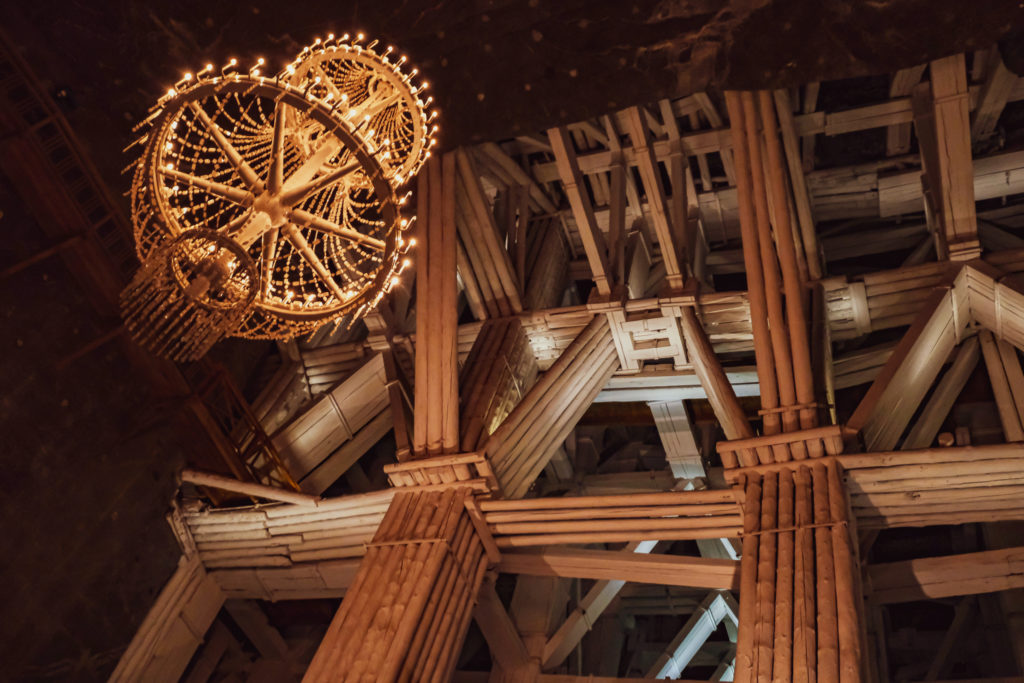
Saint Kinga’s Chapel
The chapel is named after the daughter of King Béla IV of Hungary. She lived in the 13th century and became the patron of salt miners. Legend has it that Kinga threw her engagement ring into the Maramures salt mine in Hungary. Later on they found the ring in the Wieliczka salt mine. The miners made a statue of Saint Kinga in the Wieliczka salt mine. The statue is entirely made out of salt.
The enormous St. Kinga’s chapel is built by four men. It took them 67 years to carve and decorate the chamber. The chandeliers are made of crystal salt. Each of the miners have a memorial stone in the chapel. The fourth stone is still blank because the miner is still alive.
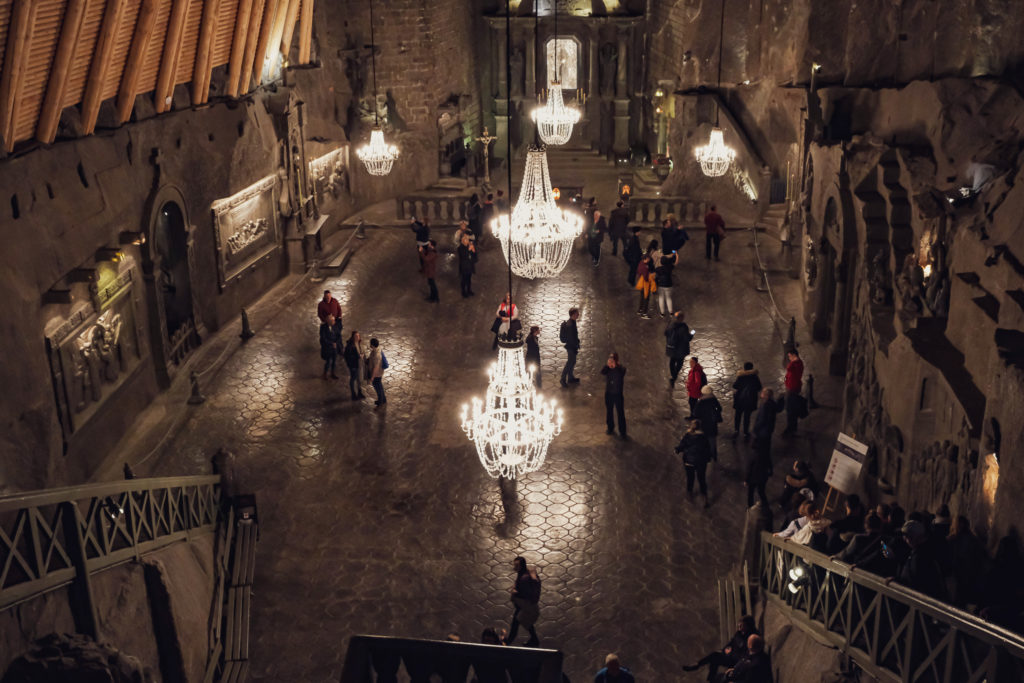
The secret Crystal Caves
The Crystal Caves are unfortunately not open for visitors. Still, it’s worth mentioning this hidden wonder. Halite is the salt we use for cooking. This mineral can crystalize. In 1860 the miners of the Wieliczka Salt Mine discovered these rare, big and beautiful salt crystals by accident. The Crystal Caves is situated at a depth of 70 and 114 meters, between Levels I and IIn. The crystals are much younger than the salt stones. And a result of secondary crystallisation of salt. Access to these caves is strictly limited. It’s only possible to visit for scientific or teaching purposes.
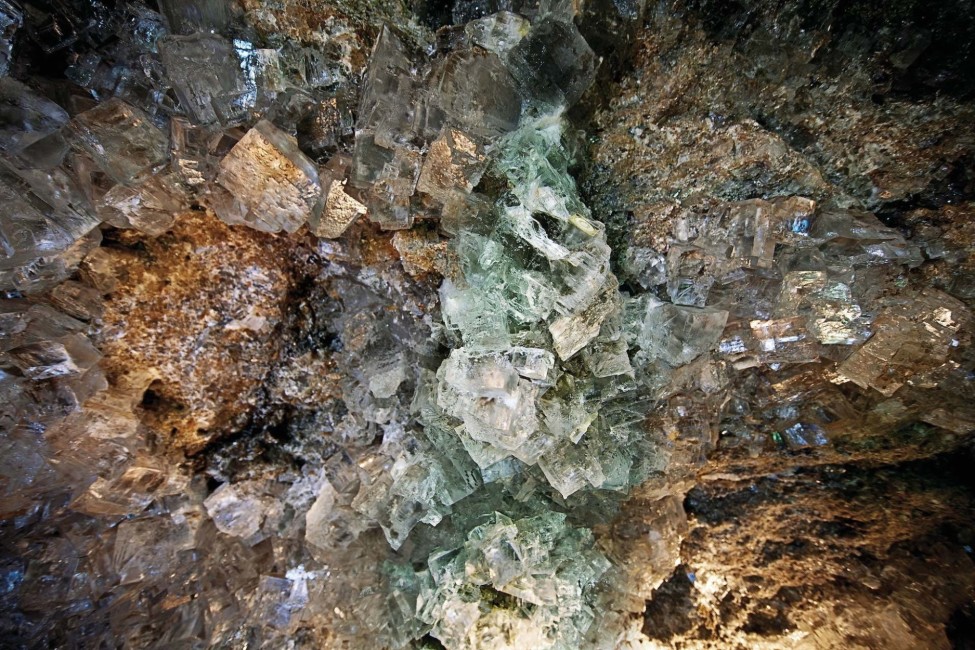
The Tourist Route
You start the tour by going down a stairs with 800 steps. Underground you are guided in a labyrinth of tunnels. Explore the underground chambers, visit several chapels and admire the saline lakes. The guide informs you about the history of the salt mines, old mining techniques and tools, transport the salt, the miners and corresponding legends. The maximum depth is 135 meter and the length is 3,5 km.
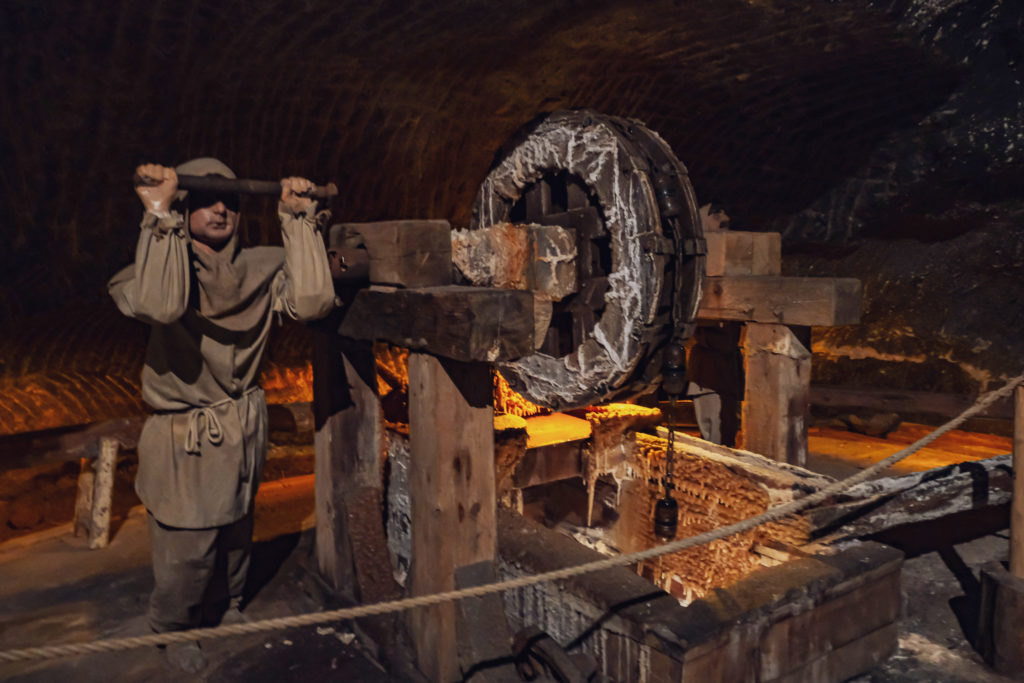
The Miner’s route
Explore the Wieliczka salt mine via the more adventurous Miner’s route. This route is doesn’t have nicely decorated tunnels and chambers. You have to overcome your fear of darkness. The tunnels are dark and you have to find your way with a flashlight. The guide gives you tasks to find salt and challenge you to find the right route. The maximum depth is 101 meter and you walk 1,9km. Walking in the dark is a bit trickier and you need more time to adjust to the darkness.
Picture gallery
The third picture is the entrance of the salt mine. As soon as your inside you walk down 800 steps. Don’t worry about the exercise. The healing air is good for your lungs and for the condition of your entire body.
Tunnels
In a few decennia the oak wooden beams change into stone because of the salt. Oak wood is used because of it’s strength. The oak beams might crack but never splinter like other sorts of wood.
Historical displays
These displays show how miners worked back in the days. In the early days they used horses for transporting the rock salts. Once the horse were in the underground mines they never went back to the surface. Miner’s were afraid that something would happen to the horses if they went up and down the mineshaft every day.
Salt statue
All these statues are made of salt and carved by miner’s.
Saint Kinga’s Chapel
The seventh picture is a salt wall sculpture showing Leonardo’s The Last Supper. Every chandelier is made of crystal salt. The floors are carved out of rock salt. The tenth picture is a salt sculpture of Pope John Paul II. The last picture shows the memorial stones of the four art miners. They carved the chapel, sculptures and other works of art.
Saline lakes
The saline or salt lakes don’t have a natural green colour. The underwater lights are green and colours the water. The percentage of salt is so high that you can’t dive into the water. You just float. The last picture is an underground event hall.
In The World’s Jungle
Check out articles about the monuments of Krakow. Or go on a virtual picture tour in Krakow or Barcelona. Are you planning to travel around in Europe? Explore the monuments in Paris or the amazing museums in Antwerp, such as Rubens House and the printing shop of Plantin-Moretus.
In The World’s Jungle – Personal Travel Guide
Interested to know more about In The World’s Jungle and the articles you can find here? Read more about it on the About page or get to know Adriana. I can help you planning your trip, find unique places to stay, set-up an itinerary and make other necessary arrangements. Feel free to contact me and let me know how I can help you. Check the Service page to learn more.


















































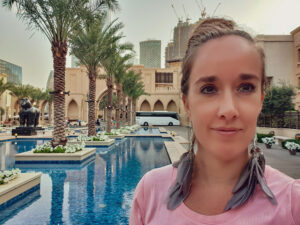
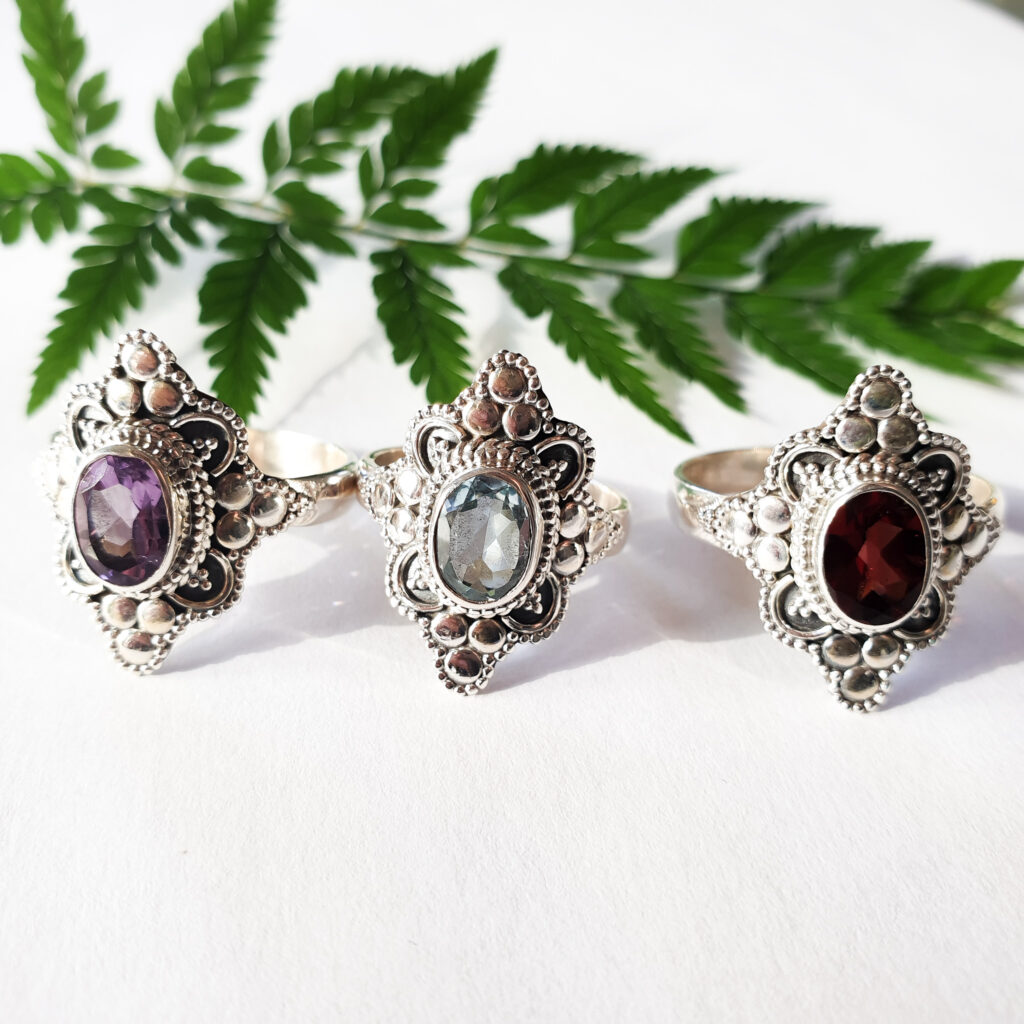
This Post Has 2 Comments
Must be an impressive place to visit… 🙂
It was an unique experience. Everything down there is built out of salt. The mine workers did a wonderful job decorating the place.